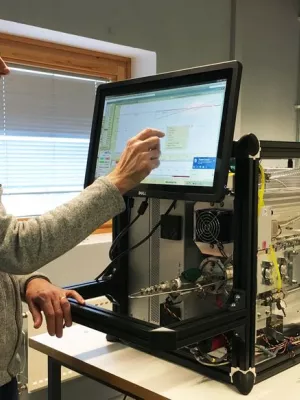
Erik Swietlicki
Professor

Organic compounds in aerosols from selected European sites - Biogenic versus anthropogenic sources
Författare
Summary, in English
Atmospheric aerosol samples from a boreal forest (Hyytiala, April 2007), a rural site in Hungary (K-puszta, summer 2008), a polluted rural area in Italy (San Pietro Capofiume, Po Valley, April 2008), a moderately polluted rural site in Germany located on a meadow (Melpitz, May 2008), a natural park in Spain (Montseny, March 2009) and two urban background locations (Zurich, December 2008, and Barcelona, February/March 2009) were collected. Aliphatics, polycyclic aromatic hydrocarbons, carbonyls, sterols, n-alkanols, acids, phenolic compounds and anhydrosugars in aerosols were chemically characterised by gas chromatography-mass spectrometry, along with source attribution based on the carbon preference index (CPI), the rations between the unresolved and the chromatographically resolved aliphatics, the contribution of wax n-alkanes, n-alkanols and n-alkanoic acids from plants, diagnostic ratios of individual target compounds and source-specific markers to organic carbon ratios. In spite of transboundary pollution episodes, Hyytiala registered the lowest levels among all locations. CPI values close to 1 for the aliphatic fraction of the Montseny aerosol suggest that the anthropogenic input may be associated with the transport of aged air masses from the surrounding industrial/urban areas, which superimpose the locally originated hydrocarbons with biogenic origin. Aliphatic and aromatic hydrocarbons in samples from San Pietro Capofiume reveal that fossil fuel combustion is a major source influencing the diel pattern of concentrations. This source contributed to 25-45% of the ambient organic carbon (OC) at the Po Valley site. Aerosols from the German meadow presented variable contributions from both biogenic and anthropogenic sources. The highest levels of vegetation wax components and biogenic secondary organic aerosol (SOA) products were observed at K-puszta, while anthropogenic SOA compounds predominated in Barcelona. The primary vehicular emissions in the Spanish city accounted for around 25-30% of the OC in aerosols. Besides the traffic input (10% of OC), residential wood burning was found to be another dominant emission source contributing to the atmospheric aerosol (up to 38% of OC) at the Swiss urban location. It was estimated that around 10% of the OC mass in the urban sites originates from cooking emissions. Aerosols from the urban area of Zurich presented a much higher PAH content, and benzo(a)pyrene equivalent concentrations sometimes exceeding the mandatory limit. (C) 2012 Elsevier Ltd. All rights reserved.
Avdelning/ar
- Kärnfysik
- NanoLund: Centre for Nanoscience
- MERGE: ModElling the Regional and Global Earth system
Publiceringsår
2012
Språk
Engelska
Sidor
243-255
Publikation/Tidskrift/Serie
Atmospheric Environment
Volym
59
Länkar
Dokumenttyp
Artikel i tidskrift
Förlag
Elsevier
Ämne
- Meteorology and Atmospheric Sciences
Nyckelord
- European aerosol
- Organic compounds
- Tracers
- Diagnostic ratios
- Benzo(a)pyrene equivalent carcinogenicity
- Sources
Aktiv
Published
ISBN/ISSN/Övrigt
- ISSN: 1352-2310